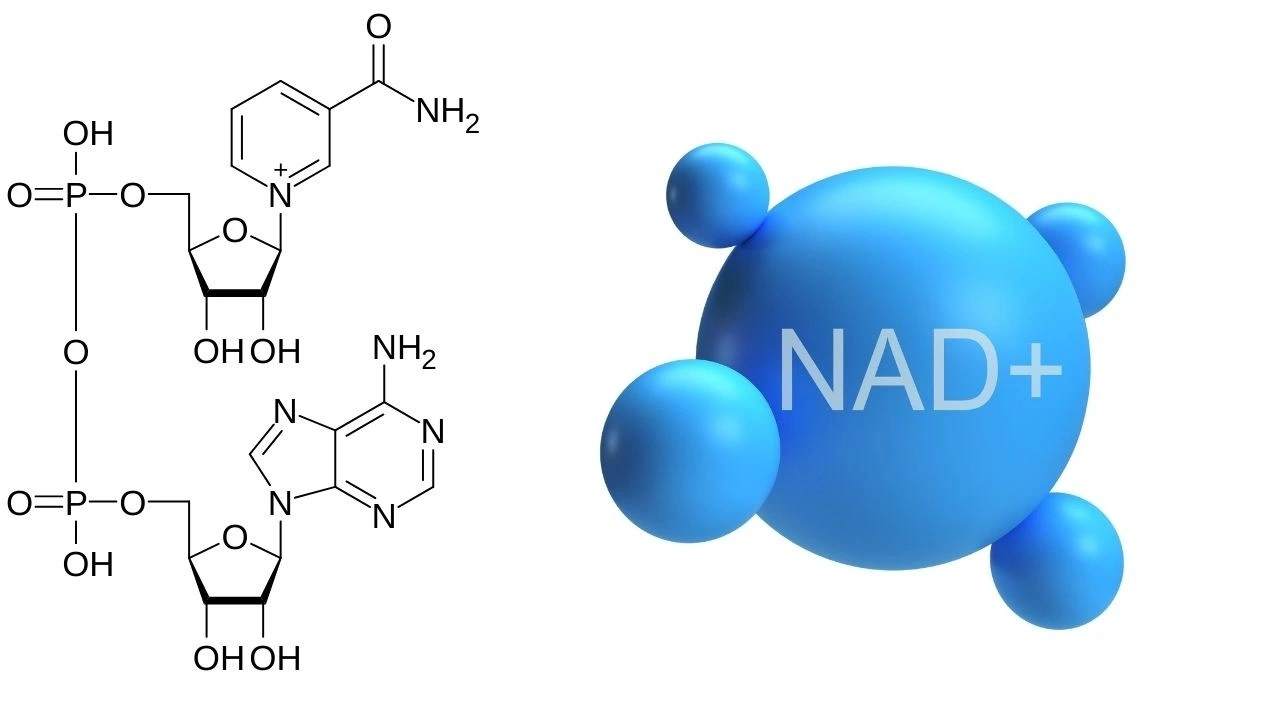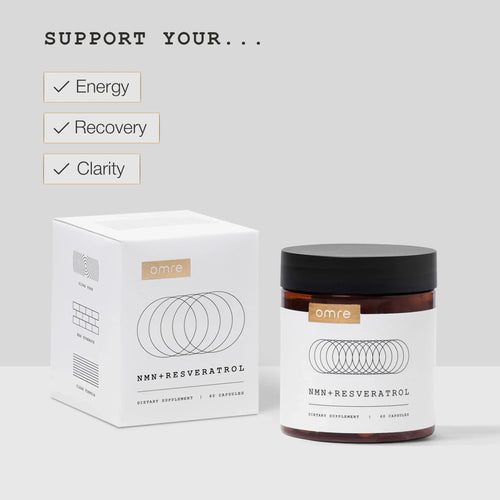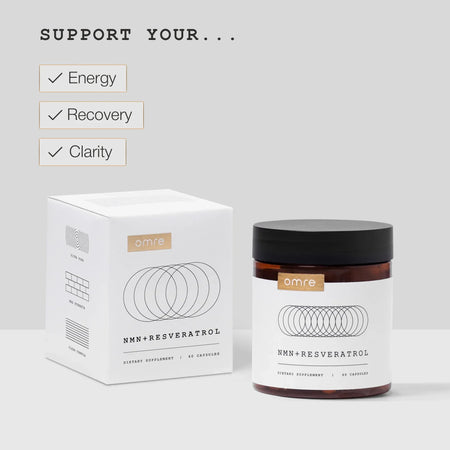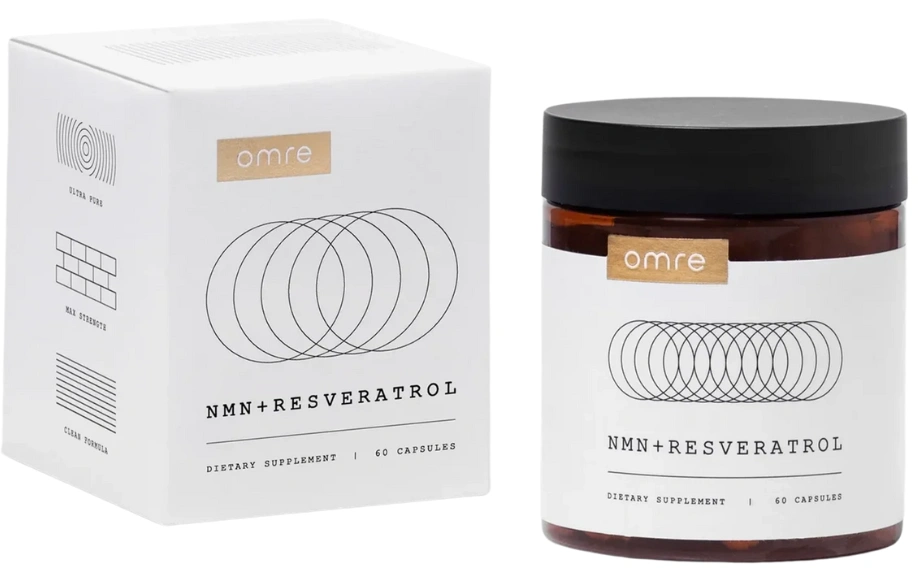Table of Contents
Cellular respiration is how your body turns food into usable energy. At the heart of this process is NAD+, a molecule that helps move energy around inside your cells.
Without NAD+, your cells wouldn't be able to make ATP, the energy currency that powers nearly everything your body does.
This guide breaks down what NAD+ is, how it works in each stage of cellular respiration, and why it matters for your energy and health.
NMN + RESVERATROL
Cellular NAD+ booster with ultra‑pure NMN and Resveratrol, at research‑backed doses.*
Key Takeaways:
NAD+ supports energy production by carrying electrons in cellular respiration.
Cellular respiration depends on NAD+ to keep glycolysis and the Krebs cycle running.
NAD+ levels decline with age, which may impact mitochondrial function and energy.
NMN helps restore NAD+ levels by acting as a direct precursor in NAD+ synthesis.
What Role Does NAD+ Play in Cellular Respiration?
NAD+ acts as an electron carrier in cellular respiration, helping convert nutrients like glucose into usable energy (ATP). It picks up electrons during glycolysis and the Krebs cycle, becomes NADH, and then delivers those electrons to the electron transport chain, where most ATP is produced.
During glycolysis, NAD+ captures electrons released as glucose breaks down into pyruvate. In the Krebs cycle, it collects even more high-energy electrons as fuel molecules are further processed.
Once converted to NADH, it carries those electrons to the mitochondria’s electron transport chain. There, the energy is used to power ATP synthase, the enzyme that creates ATP.
Without NAD+, this chain of reactions would stall. Cells wouldn’t be able to harvest energy from food efficiently, and ATP production would sharply decline, affecting everything from brain function to muscle activity.
That’s why NAD+ is so central to how your cells stay alive and energized.
What Is NAD+?

NAD+ is a molecule that helps your cells turn food into energy by carrying electrons during cellular respiration. It stands for nicotinamide adenine dinucleotide, and it plays a key role in redox (reduction-oxidation) reactions.
In simple terms, NAD+ picks up electrons during chemical reactions and helps move that energy where it's needed.
NAD+ exists in two forms:
NAD+ (oxidized form), which accepts electrons
NADH (reduced form), which carries those electrons to where they can be used
Your body makes NAD+ from vitamin B3 (niacin) and other precursors like NMN and NR. Because it's involved in hundreds of reactions, scientists call it a “coenzyme.”
That just means it helps enzymes do their jobs, especially the ones involved in energy production, DNA repair, and cell health.
Why Your Cells Rely on It
Your cells depend on NAD+ to stay alive and keep producing energy efficiently. It’s one of the most important molecules in metabolism.
Here’s why NAD+ is so important:
Helps break down glucose into usable energy
Transfers high-energy electrons to the electron transport chain
Fuels ATP production, your body’s main energy source
Supports DNA repair and cell survival
Needed by sirtuins, the “longevity proteins” linked to aging and stress response
Acts as a coenzyme in over 400 enzymatic reactions
When NAD+ levels drop (which happens naturally with age), energy production slows down, and cells may become more prone to damage.
The 3 Main Stages of Cellular Respiration
Cellular respiration has three main stages: glycolysis, the Krebs cycle, and oxidative phosphorylation. NAD+ plays a key role in each step by carrying electrons that are released as glucose is broken down.
Let’s walk through each stage and see where NAD+ fits in.
Glycolysis (Happens in the Cytoplasm)
Glycolysis is the first step of cellular respiration. It breaks down one molecule of glucose (a 6-carbon sugar) into two molecules of pyruvate (3-carbon compounds). This step takes place in the cytoplasm and doesn’t need oxygen.
How NAD+ helps:
NAD+ picks up electrons released when glucose is broken down.
It gets reduced to NADH in the process.
For every glucose molecule, two NAD+ are converted into two NADH.
These NADH molecules will later enter the mitochondria and help generate ATP in the final stage.
Krebs Cycle (Happens in the Mitochondria)
Also called the citric acid cycle or TCA cycle, this step finishes breaking down the fuel from glycolysis and captures even more high-energy electrons.
How it works:
Pyruvate from glycolysis is converted into acetyl-CoA.
Acetyl-CoA enters the cycle and undergoes a series of enzyme reactions.
During these reactions, carbon dioxide is released, and more NAD+ is reduced to NADH.
Where NAD+ comes in:
NAD+ is involved in key steps like isocitrate → alpha-ketoglutarate and alpha-ketoglutarate → succinyl-CoA.
For every acetyl-CoA molecule, three NADH are produced.
These NADH molecules are packed with stored energy and head to the next stage.
Oxidative Phosphorylation (Electron Transport Chain)
This is the final stage and the main source of ATP in most cells. It happens across the inner membrane of the mitochondria.
What happens here:
NADH from the earlier stages donates its electrons to the electron transport chain (ETC).
These electrons move through a series of proteins embedded in the membrane.
As they move, they help pump protons across the membrane, creating a gradient.
This gradient powers ATP synthase, the enzyme that produces ATP.
At the end, oxygen accepts the electrons and combines with protons to form water.
Key point:
NADH → NAD+ again in this process, making it available to go back and help with glycolysis and the Krebs cycle. This recycling is vital.
NMN + RESVERATROL
Cellular NAD+ booster with ultra‑pure NMN and Resveratrol, at research‑backed doses.*
Why NAD+ Regeneration Keeps Everything Running
NAD+ regeneration is necessary for cellular respiration to continue, especially in glycolysis and the Krebs cycle. Without it, cells would run out of usable NAD+, and energy production would stall.
When NAD+ picks up electrons during metabolism, it becomes NADH. That’s great for carrying energy, but unless it turns back into NAD+, your cells can’t keep the cycle going.
Think of it like a delivery truck; once it drops off its load, it needs to return to pick up the next one. Regeneration is what makes that return trip possible.
In aerobic conditions (when oxygen is available), NADH is recycled back to NAD+ through the electron transport chain. This not only regenerates NAD+ but also powers the production of large amounts of ATP.
However, if oxygen is scarce, cells rely on fermentation to convert NADH back to NAD+, like in muscle cells during intense exercise, where lactic acid is formed.
This constant recycling keeps your metabolic engine humming. If NAD+ isn’t replenished, even short disruptions can lead to energy drops, fatigue, and impaired cell function.
How NAD+ Links to Aging, Energy, and Supplement Trends
 NAD+ isn’t just a player in cellular respiration, it’s also tied to how we age and how energetic we feel as we get older.
NAD+ isn’t just a player in cellular respiration, it’s also tied to how we age and how energetic we feel as we get older.
Here’s how NAD+ connects to bigger health conversations:
Age-related decline: NAD+ levels naturally drop with age. Research shows that this decline is linked to lower energy, weaker metabolism, and reduced DNA repair activity. This may explain why older adults often experience fatigue or slower recovery.
Sirtuins and longevity: Sirtuins are a group of proteins involved in aging and stress resistance. They rely on NAD+ to function. Lower NAD+ means reduced sirtuin activity, which may affect inflammation, mitochondrial health, and cellular repair.
Mitochondrial function: Mitochondria, the cell’s power plants, need NAD+ to run efficiently. Studies suggest that improving NAD+ levels can support mitochondrial performance and overall metabolic health (1).
Supplement interest (NMN and NR): Scientists have explored compounds like NMN (nicotinamide mononucleotide) and NR (nicotinamide riboside) because they are NAD+ precursors. Early animal studies and some human trials suggest they may help replenish NAD+ levels, but research is still ongoing (2).
- Cautious optimism: While interest in NAD+ boosters is growing, most experts agree more large-scale human studies are needed. The science is promising but not conclusive.
How to Increase NAD+ Naturally
 While NAD+ levels drop with age, there are several ways to support your body’s ability to maintain or restore them. These strategies include both natural habits and scientifically studied compounds.
While NAD+ levels drop with age, there are several ways to support your body’s ability to maintain or restore them. These strategies include both natural habits and scientifically studied compounds.
Exercise Regularly
Physical activity is one of the most effective ways to naturally raise NAD+ levels. When you move, your muscles require more energy, and this increased demand stimulates NAD+ production to keep up with cellular energy needs.
Aerobic exercise, like jogging or cycling, appears especially helpful.
Studies have shown that endurance training may activate enzymes that help recycle NADH back into NAD+, improving mitochondrial efficiency and overall metabolism (3).
Even moderate activity a few times a week can support this pathway.
Practice Intermittent Fasting or Caloric Restriction
Eating less, or less often, may help preserve and increase NAD+.
Caloric restriction has been shown in animal studies to increase NAD+ levels and activate sirtuins, the proteins tied to longevity and cellular repair (4).
Intermittent fasting works in a similar way by placing short-term energy stress on cells, which encourages them to produce more NAD+ to adapt.
This doesn't mean extreme dieting is necessary, but time-restricted eating or occasional fasting can nudge your metabolism in a favorable direction.
Avoid Excessive Alcohol and Processed Foods
What you don’t consume matters too. Excess alcohol can drain your NAD+ reserves because it's used heavily in alcohol metabolism.
Over time, this may contribute to NAD+ depletion and impaired liver function.
Similarly, high sugar and ultra-processed foods promote inflammation and oxidative stress, which may increase NAD+ consumption during cell repair.
Eating a whole-food diet rich in leafy greens, legumes, and lean proteins can support better balance.
Get Good Sleep and Manage Stress
Sleep is when your body does a lot of its repair work, and that includes using NAD+ to fix DNA and support immune function.
Chronic stress and poor sleep may trigger more oxidative damage and NAD+ depletion.
Getting consistent, restful sleep and using techniques like mindfulness or deep breathing can help protect your cells from burnout, literally.
Consider NAD+ Precursors (NMN and NR)
Your body makes NAD+ using compounds like nicotinamide riboside (NR) and nicotinamide mononucleotide (NMN). These are called NAD+ precursors; they’re the building blocks your cells use to produce more of it.
Both NMN and NR are found in small amounts in foods like milk, broccoli, and avocados, but research suggests that larger amounts may be needed to significantly impact NAD+ levels, especially as we age.
Conclusion
NAD+ plays a central role in how your body turns food into energy. It helps drive each stage of cellular respiration, from breaking down glucose in glycolysis to powering ATP production in the mitochondria.
Without enough NAD+, your cells can’t function at full capacity, and energy levels can take a hit.
As we age, NAD+ levels naturally decline. This can affect not just how we feel day to day, but also how well our bodies handle stress, repair DNA, and support long-term health.
Thankfully, there are ways to support NAD+, through exercise, smart nutrition, good sleep, and scientifically studied precursors like NMN.
Want to support your energy, focus, and cellular health as you age?
Try Omre NMN + Resveratrol, a research-backed formula designed to support healthy NAD+ levels and mitochondrial function.
Why it works: NMN helps replenish NAD+, while resveratrol activates sirtuins — together they support healthy aging and energy metabolism.
Why it’s trusted: Omre uses high-quality, third-party tested ingredients with no unnecessary fillers.
- Why now: NAD+ declines start in your 30s, but the earlier you support it, the better your cells can keep up.
Check the availability now and fuel your body at the cellular level.
FAQs
What happens if cells run out of NAD+?
If cells run out of NAD+, key steps in cellular respiration, like glycolysis and the Krebs cycle, come to a halt. This means energy production stops, which can lead to cell dysfunction or death.
Is NAD+ used up or recycled?
NAD+ isn’t permanently used up; it’s recycled. After accepting electrons and becoming NADH, it’s later converted back to NAD+ in the electron transport chain or through fermentation.
How is NAD+ different from NADH?
NAD+ is the oxidized form that accepts electrons, while NADH is the reduced form that carries those electrons to the electron transport chain. They’re two sides of the same process, energy transfer.
Does NAD+ affect aging and energy?
Yes, NAD+ levels influence how efficiently your cells produce energy and repair damage. As NAD+ declines with age, it can impact mitochondrial function, fatigue levels, and cellular repair systems linked to aging.






